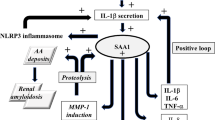Abstract
Amyloidosis (A) related to familial Mediterranean fever (FMF) causes serious morbidity and mortality in children. Our study evaluates serum levels of apolipoprotein (Apo) AI, AII, B, and E and Apo AII/AI ratios as a non-invasive diagnostic tool for amyloidosis in children with FMF and FMF-A. Results were compared with those of patients with childhood nephrotic syndrome (NS) and healthy children (controls). Significantly lower serum levels of Apo AI (90.20±28.30 mg/dl) were documented in patients with FMF-A than in all other groups (FMF 126.89±51.07 mg/dl, NS 140.38±33.73 mg/dl, and controls 134.67±12.73 mg/dl) (P<0.01). Diagnostic sensitivity, specificity, and predictive value for this test were 85%, 80%, and 85%, respectively. Apo AII/AI ratio results were essentially equal in all groups (P>0.05). It is concluded that a decreased Apo AI serum level, but not Apo AII/AI ratio, is a useful, non-invasive test for the early diagnosis of FMF-A in children.
Similar content being viewed by others
References
Sohar E, Gafni J, Pras M, Heller H (1967) Familial Mediterranean fever. A survey of 470 cases and review of the literature. Am J Med 43:227–253
Pras E, Aksetijevich I, Gruberg L, Balow JE, Prosen L, Dean M, Steinberg AD, Pras M, Kastner DL (1992) Mapping of a gene causing familial Mediterranean fever to the short arm of chromosome 16. N Engl J Med 326:1509–1513
Saatci U, Bakkaloglu A, Ozen S, Besbas N (1993) Familial Mediterranean fever and amyloidosis in children. Acta Paediatr 82:705–706
Glenner GG (1980) Amyloid deposits and amyloidosis. The β-fibrilosis. N Engl J Med 136:1283
Robbins SL, Kumar V (1987) Amyloidosis. In: Robbins SL, Kumar V (eds). Basic pathology,4th edn. Saunders, Philadelphia, pp 214–221
Gedalia A (2000) Amyloidosis. In: Behrman RE, Kliegman MR, Jenson HB (eds) Nelson textbook of pediatrics, 16th edn. Saunders, Philadelphia, pp 724–725
Hawkins PN, Mayers MJ, Lavender JP, Pepys MB (1988) Diagnostic radionuclide imaging of amyloid: biological targeting by circulating human serum amyloid P component. Lancet I:1413–1418
Yamada T, Ozawa T, Gejyo F, Okuda Y, Takasugi K, Hotta O, Itoh Y (1988) Decreased serum apolipoprotein AII/AI ratio in systemic amyloidosis. Ann Rheum Dis 57:249–251
Ando Y, Tanaka Y, Ueyama H, Sakashita N, Yonekawa T, Higuchi K, Araki S (1993) Low plasma apolipoprotein AII levels in human and mouse amyloidosis with mutant transthretin (Met-30) gene. Ann Neurol 33:101–103
Livneh A, Langevitz P, Zemer D, Zaks N, Kees S, Lidar T, Migdal A, Padeh S, Pras M (1997) Criteria for the diagnosis of familial Mediterranean fever. Arthritis Rheum 40:1879–1885
International Study of Kidney Disease in Children (1981) The primary nephrotic syndrome in children. Identification of patients with minimal change nephrotic syndrome from initial response to prednisone. J Pediatr 98:561–564
Burtis C, Ashward E (1994) Lipids, lipoproteins and apolipoproteins. In: Burtis C, Ashward E (eds) Tietz textbook of clinical chemistry, 2th edn. Saunders, Philadelphia, pp 1019–1024
Zemer D, Pras M, Sohar E, Modan M, Cabili S, Gafni J (1986) Colchicine in the treatment and prevention of amyloidosis of familial Mediterranean fever. N Engl J Med 314:1001–1005
Zemer D, Livneh A, Langevitz P (1992) Reversal of the nephrotic syndrome by colchicine in amyloidosis of familial Mediterranean fever. Ann Intern Med 116:426
Simsek B, Islek I, Simsek T, Kucukoduk S, Cengiz K (2000) Regression of amyloidosis due to familial Mediterranean fever by colchicine. Nephrol Dial Trans 15:281–282
Saatci U, Ozen S, Ozdemir S, Bakkaloglu A, Besbas N, Topaloglu R, Arslan S (1997) Familial Mediterranean fever in children: report of a large series and discussion of the risk and prognostic factors of amyloidosis. Eur J Pediatr 156:619–623
Kocak H, Besbas N, Saatci U, Bakkaloglu A (1989) Amyloidosis in children with familial Mediterranean fever. Turk J Pediatr 31:281–287
Tanaka Y, Ando Y, Kumamoto T, Miyazaki A, Nakamura M, Nakayama M, Araki S, Ando M (1994) Changed affinity of apolipoprotein AII to high density lipoprotein (HDL) in patients with familial amyloidotic polyneuropathy (FAP) type I. Biochim Biophys Acta 1225:311–316
Kher KK (1992) Nephrotic syndrome. In: Kher KK, Makker SP (eds) Clinical pediatric nephrology. McGraw Hill, New York, pp 144–145
Acknowledgement
The authors wish to thank the critical review of the statistical analysis of Professor Dr. Yuksel Bek and Dr. Sevgi Canbaz.
Author information
Authors and Affiliations
Corresponding author
Rights and permissions
About this article
Cite this article
İşlek, İ., Şimşek, T., Baskın, E. et al. Low serum apolipoprotein AI levels in amyloidosis related to familial Mediterranean fever. Pediatr Nephrol 18, 1005–1008 (2003). https://doi.org/10.1007/s00467-003-1227-9
Received:
Revised:
Accepted:
Published:
Issue Date:
DOI: https://doi.org/10.1007/s00467-003-1227-9




